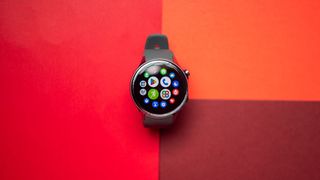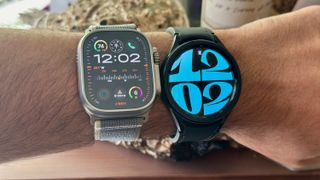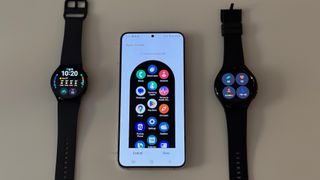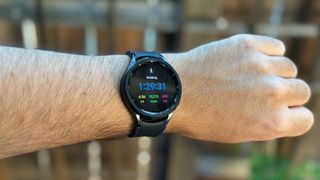Samsung's rumored Galaxy Watch Ultra has only one path to success
We can expect the Galaxy Watch Ultra to have a larger display and better battery life. It needs more than that, if Samsung can manage it.

Leaks and hints from Samsung point to a Galaxy Watch Ultra watch arriving this summer instead of the long-rumored 7 Pro. We'll find out the truth at the next Unpacked event; the real question is, what will a Samsung "Ultra" watch look like, and how will it differentiate itself from the Apple Watch Ultra series?
Last week, I finished my Apple Watch Ultra 2 review, saying, "Your move, Samsung," because I hoped the brand would take inspiration from its premium features for the upcoming Galaxy Watch 7 Pro. Days later, by happy coincidence, Samsung said it would launch "new premium models" of Galaxy Watches with "upgrades" during its Q1 2024 earnings call. Its execs didn't elaborate, but soon after, Android Headlines claimed to have spotted "Ultra" and "Fan Edition" watch model names in its One UI beta code.
I don't care whether it's called the Galaxy Watch Ultra, 7 Ultra, or 7 Pro. What matters to me, after reviewing the Galaxy Watch 5 Pro and Galaxy Watch 6 Classic, is that Samsung gets its "premium" smartwatch right from the start, even if it has to steal tricks from Apple, OnePlus, Garmin, or other brands to do so.
It should kick Apple's a** in battery life
The Galaxy Watch 5 Pro launched in 2022 with pretty consistent three-day battery life, but natural capacity drain and annual One UI updates cut into its battery life. My colleague Andrew Myrick, who owns the 80-hour 5 Pro and the 36-hour Apple Watch Ultra, says his Ultra lasts longer in 2024.
A Wear OS flagship, Samsung-made or otherwise, will cost as much as a mid-range smartphone if not more. An "Ultra" watch needs the longevity to match, or Samsung's most loyal customers will feel burned.
An April Samsung leak indicated its next flagship smartwatch would have a 578mAh capacity, on par with the Watch 5 Pro. We rarely see any watch hit above 600mAh; more capacity would make any watch too thick or heavy. So, how will Samsung make its Ultra last longer than the Pro? I can only think of one option.

The new Wear OS hybrid interface debuted with the 100-hour OnePlus Watch 2, but any watch can use it. Without diving into minutiae, Wear OS watches can assign background tasks like notifications, watch face data, and heart rate tracking to a low-power co-processor, saving the battery-guzzling tasks for the main processor.
Be an expert in 5 minutes
Get the latest news from Android Central, your trusted companion in the world of Android
Almost all Android watches use a processor and co-processor, but Exynox chips appear to be the exception. The last model's Exynos W930 chip had dual Cortex-A55 cores, for instance; compare that to the Pixel Watch 2's Snapdragon W5, which has four Cortex-A53 cores and a 22nm Cortex M55 co-processor.
Samsung watches are fast and long-lasting, but it needs to prove the Galaxy Watch Ultra will still be "premium" four years from now.
Samsung watches have excellent, efficient performance speed. Transitioning to a power-saving hybrid system might be harder for Samsung and its Exynos division than its Qualcomm-reliant rivals.
Maybe the rumored Exynos W940 could change that; it's supposed to be 50% more efficient. But Samsung could easily cancel out that efficiency with more RAM to achieve Ultra-quality speed.
The other (unlikely) option is for Samsung to add a secondary grayscale screen that kicks in whenever the battery is low. It's the method used by the Mobvoi Ticwatch Pro 5, and it works really well! But the Samsung display leaks I've heard have revolved around squircles or micro-LED tech, so I wouldn't count on it.
I don't know what an "Ultra" Android watch looks like

At 61g, the Apple Watch Ultra 2 falls on the edge of comfort, thanks to the light nylon strap and reasonably thin titanium case. It also has a 1.9-inch display — squircle-shaped, obviously — which makes reading notifications a breeze.
Compare that to the 1.5-inch Galaxy Watch 6 Classic, which weighs a mere two grams less thanks to its rotating bezel and stainless steel frame. You'd assume that a Galaxy Watch Ultra would have an even larger display to live up to the name, but you'd reach a point where smaller wrists couldn't bear the weight.
Samsung can (A) go painfully heavy with a rotating bezel, (B) go capacitive despite the drawbacks, or (C) take the Apple/Google route with a crown.
The Galaxy Watch 5 Pro kept its weight down with its capacitive bezel. When I polled my colleagues, however, they collectively insisted that any Ultra watch would need a better solution — either the rotating bezel or a crown. They'd prioritize useability over comfort.
Samsung allegedly wants to switch to a squircle Galaxy Watch in the future, but Android watch owners see that as the purview of Apple and its imitators; they might hate the switch for its look, even if the square screen makes reading and typing easier. Still, I can't think of another way to get a bigger display without killing our wrists.
Samsung won't let the Ultra stand on its own merits

Samsung likes to make its devices interconnected, the same as Apple. It's why you need a Samsung phone to check Galaxy Watch ECG readings, or why Samsung is "working on" making the Galaxy Ring compatible with other non-Galaxy phones.
That's probably not going to change with the Galaxy Watch Ultra, even if it costs enough to be a standalone device. It'll probably have built-in cellular data for calling and all the health sensors in the world — maybe even blood sugar monitoring — but Samsung will still want you to analyze your data on its phone.
Naturally, die-hard Samsung fans with disposable income will buy a Galaxy Watch Ultra with their S24 Ultras, because they want the best possible tech at all times — the same with Apple Watch Ultra 2 buyers. The question is whether Samsung can step outside of that niche, and what kind of value it can offer besides "big battery, big screen."

In the future, AI like Gemini will be the backbone of wearable tech, giving you a natural way to access information or send replies without being dependent on a tiny screen. However, the rough launches for the Rabbit R1 and Humane AI pin prove how far off that future is.
Thankfully, there's another "AI" option Samsung can take.
Samsung's Ultra path ahead is health and fitness
Aside from Apple nerds, one type of person consistently buys smartwatches in the $500–$1,000 range: athletes, gym rats, and fitness freaks.
That's why Apple started going all-out on fitness the year the Ultra came out, focusing on runners, hikers, and cyclists. It targeted people who would normally spend a grand on premium Garmin watches like the Epix or Fenix.
Serious athletes won't settle for any traditional smartwatch because they need weeks of battery life, not days. However, Apple still won over the weekend warrior types who want solid fitness features when they have time but better smarts and apps during the week.

I've been harping on Samsung's lack of fitness progress over the last couple of years. To its credit, the Galaxy Watch 5 Pro did add offline GPX maps, a popular feature on fitness watches. However, it took them until last year to add heart rate zones, and Samsung still lags behind in areas like GPS accuracy and daily readiness.
Samsung will take a stride forward for health tracking this summer with the Galaxy Ring, which will give you a daily "Vitality Score" based on your sleep quality. Samsung will call it an "AI" tool, but it's basically the same algorithm other fitness watch brands have used for the last few years.
The next step is to incorporate workout data and your VO2 Max level to determine how long to recover after a workout or how many active workout minutes you need that day to get fitter safely. It's the key feature Garmin and Fitbit watches offer, and I've no doubt Apple is working on its own version.
Even if some people only want the Galaxy Watch Ultra to be as RAM-packed, long-lasting, and massive as possible, Samsung can't escape the fact that plenty of people see watches as a training tool or health tracker, first and foremost. Beyond the Android super-fans, no one will buy an "Ultra" watch that doesn't go above and beyond for fitness software.

Michael is Android Central's resident expert on fitness tech and wearables, with an enthusiast's love of VR tech on the side. After years freelancing for Techradar, Wareable, Windows Central, Digital Trends, and other sites on a variety of tech topics, AC has given him the chance to really dive into the topics he's passionate about. He's also a semi-reformed Apple-to-Android user who loves D&D, Star Wars, and Lord of the Rings.
For wearables, Michael has tested dozens of smartwatches from Garmin, Fitbit, Samsung, Apple, COROS, Polar, Amazfit, and other brands, and will always focus on recommending the best product over the best brand. He's also completed marathons like NYC, SF, Marine Corps, Big Sur, and California International — though he's still trying to break that 4-hour barrier.
-
JohnMiller2013 Rectangle or GTFO.Reply
It is not 1910 anymore. Smartwatches do not have physical hands that turn in circles. So why are so many of them circular? Is it THAT important to people to preserve an old status quo of watches being circular?
There is a reason why smartphones are not circular.
There is a reason why tablets are not circular.
There is a reason why computer monitors are not circular.
There is a reason why books are not circular.
It has to do with how much text you can fit on a reading surface.
Please, Samsung, Google, anybody, make a good Android Wear watch that is not circular! -
BerryBubbles Reply
I also like round watch faces.rvbfan said:I like round watch faces.
I don't find the look of a rectangle watch strapped to my wrist particularly attractive. -
Laura Knotek Replyrvbfan said:I like round watch faces.
So do I. I never had a tank style mechanical watch. I like the style of diving watches with large bezels.BerryBubbles said:I also like round watch faces.
I don't find the look of a rectangle watch strapped to my wrist particularly attractive.
